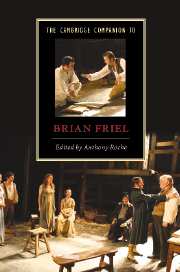Book contents
- Frontmatter
- 1 Introduction
- 2 The early plays
- 3 Surviving the 1960s: three plays by Brian Friel 1968-1971
- 4 Friel and the Northern Ireland “Troubles” play
- 5 Family affairs: Friel’s plays of the late 1970s
- 6 Five ways of looking at Faith Healer
- 7 Translations, the Field Day debate and the re-imagining of Irish identity
- 8 Dancing at Lughnasaand the unfinished revolution
- 9 The late plays
- 10 Friel’s Irish Russia
- 11 Friel and performance history
- 12 Friel’s dramaturgy: the visual dimension
- 13 Performativity, unruly bodies and gender in Brian Friel’s drama
- 14 Brian Friel as postcolonial playwright
- Bibliography
- Index
8 - Dancing at Lughnasaand the unfinished revolution
Published online by Cambridge University Press: 28 January 2007
- Frontmatter
- 1 Introduction
- 2 The early plays
- 3 Surviving the 1960s: three plays by Brian Friel 1968-1971
- 4 Friel and the Northern Ireland “Troubles” play
- 5 Family affairs: Friel’s plays of the late 1970s
- 6 Five ways of looking at Faith Healer
- 7 Translations, the Field Day debate and the re-imagining of Irish identity
- 8 Dancing at Lughnasaand the unfinished revolution
- 9 The late plays
- 10 Friel’s Irish Russia
- 11 Friel and performance history
- 12 Friel’s dramaturgy: the visual dimension
- 13 Performativity, unruly bodies and gender in Brian Friel’s drama
- 14 Brian Friel as postcolonial playwright
- Bibliography
- Index
Summary
When Dancing at Lughnasa premiered at Dublin's Abbey Theatre in 1990 it was the first time in ten years that Brian Friel had presented work unconnected to Derry's Field Day Theatre Company or the Troubles of Northern Ireland. This play is firmly situated within the 1930s Irish Republic and focuses on difficulties facing women struggling to realize themselves in a society whose revolution produced not greater opportunities for women but a codification of secular and religious paternalism. What Dancing at Lughnasa shares with previous Friel plays like Translations (1980) and Making History (1988) is an awareness of the past as connected to the present. The play takes the pulse of the 1930s, but also of the 1980s by recognizing the unfinished revolution in the lives of Irish women.
Since before independence, the defining characteristics of Irish identity have been embedded in the island's rural west, often portrayed as the picturesque embodiment of the purest, because most Celtic, Irish culture. In the independent state that emerged in the 1920s the image of suffering Mother Ireland joined the ideal of the “sainted” Irish mother to become a hallmark of national patriarchal assumptions. The Republic's 1937 Constitution famously incorporated not only the tenets of conservative Catholicism, but also a romantic vision of Irish woman, a term that clearly meant “wife and mother”: her “life” (not her work) within the home “gives to the State a support without which the common good cannot be achieved.” Such legislative paternalism restricted women's roles outside the home and granted them less than equal citizenry. It was widely criticized at the time (usually by women) for its failure to preserve the promise of equality offered in both the 1916 Declaration and the 1922 Constitution. And it forms the background for Dancing at Lughnasa.
- Type
- Chapter
- Information
- The Cambridge Companion to Brian Friel , pp. 78 - 90Publisher: Cambridge University PressPrint publication year: 2006
- 1
- Cited by



